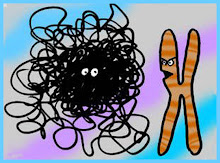Needless to say, the integrity of the umbilical cord is very crucial to the baby's growth and survival inside the uterus. Any abnormality in anatomy or any impingement upon the blood vessels passing through the cord could compromise the life of the baby.
The image above is that of a newborn baby with part of it's umbilical cord still attached. Notice the bluish-black knot at the end of the cord, near the tip of the metal forceps. This is a True Knot in the umbilical cord where factors like an extra lengthy cord and a baby that kept flipping and turning when it was smaller contributed to the knot formation. Varying types of cord coils around the baby's neck, limbs and body are quite common (5-20% of births) but a true knot is a rare occurrence ( 0.1 to 1% of pregnancies)

A closer look at the knotted umbilical cord (near the tip of the metal forceps). Notice the thick and greasy-looking vernix caseosa on the baby's arm that have not been completely wiped off yet.
Just to show contrast, this is how a pseudoknot or a false umbilical cord knot looks like. it is not a true knot, but just an exaggerated loop of one of the umbilical arteries because it is longer than the vein.






2 comments:
they never show this icky appearance of newborn babies at the movies hehehe! :-)
!!
This isn't super icky pa gani, di ba. Most of the blood and greasy goo have been wiped off na. The babies in 99% of movies are so not-newborn-looking! Heheh.
Post a Comment